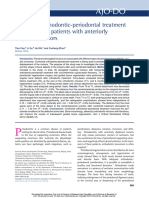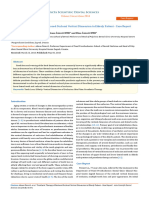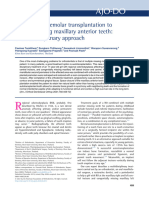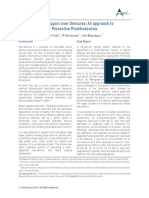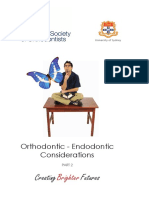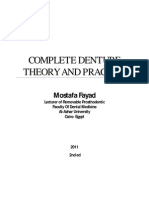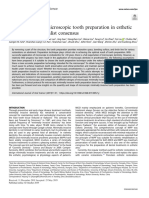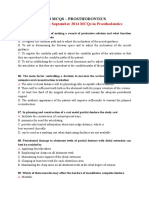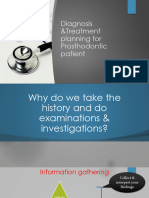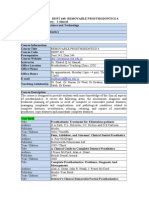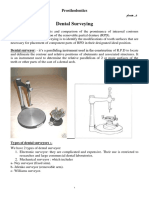Professional Documents
Culture Documents
Prosthodontic Rehabilitation Alternative of Maxillary Dentoalveolar Defect in A Patient With Cleft Lip and Palate (CLP) Case Report
Original Title
Copyright
Available Formats
Share this document
Did you find this document useful?
Is this content inappropriate?
Report this DocumentCopyright:
Available Formats
Prosthodontic Rehabilitation Alternative of Maxillary Dentoalveolar Defect in A Patient With Cleft Lip and Palate (CLP) Case Report
Copyright:
Available Formats
Volume 8, Issue 5, May – 2023 International Journal of Innovative Science and Research Technology
ISSN No:-2456-2165
Prosthodontic Rehabilitation Alternative of Maxillary
Dentoalveolar Defect in a Patient with Cleft Lip and
Palate (CLP): Case Report
1 4
Dr. Balkis Khadhraoui Dr. Zohra Nouira ( Professor)
Department of Fixed Prosthodontics, Department of Fixed Prosthodontics,
Dental Faculty of Monastir, Dental Faculty of Monastir,
University of Monastir, Tunisia University of Monastir, Tunisia
2 5
Dr. Raouf Turki Dr. Belhassen Harzallah ( Professor)
Department of Fixed Prosthodontics, Department of Fixed Prosthodontics,
Dental Faculty of Monastir, Dental Faculty of Monastir,
University of Monastir, Tunisia University of Monastir, Tunisia
3 6
Dr. Yosra Gassara (Assistant Professor) Dr. Mounir Cherif ( Professor)
Department of Fixed Prosthodontics, Department of Fixed Prosthodontics,
Dental Faculty of Monastir, Dental Faculty of Monastir,
University of Monastir, Tunisia University of Monastir, Tunisia
Abstract:- Cleft lip and palate are common birth Thanks to advanced knowledge of craniofacial growth
defects, occurring in approximately 1 in 800 births. and development, along with enhanced surgical and
Most clefts are believed to be caused by a combination orthodontic treatments, patients with cleft palate now
of genetic and non-genetic factors. It may be attributed receive improved care and in a more efficient manner (2) .
to factors such as malnutrition, irradiation during As a result, they require fewer prosthetic interventions.
pregnancy, psychological stress, teratogenic agents, However, prosthetic treatment still plays a crucial role in
infectious agents (viruses), and heredity. There are cleft palate care. (3)
various options available to treat the missing soft and
hard tissues, including removable dental prostheses, Cleft palate patients often have missing anterior teeth
fixed dental prostheses, and implant prostheses. since birth. The lateral incisors are the most commonly
However, different authors have different opinions on missing teeth in unilateral or bilateral clefts, although the
the standard of care for prosthetic treatment of cleft lip canines and central incisors may also be affected (4) . In
and palate. Some prefer removable prostheses, while cases where the teeth are present, they may be malformed
others recommend conventional tooth-supported fixed or malpositioned. Moreover, the bone support for teeth near
dental prostheses. This case report describes prosthetic the cleft is typically compromised (5)
treatment of a congenital cleft lip and palate, where a
direct zirconia-ceramic fixed dental prosthese was Various authors have presented different standards for
chosen based on the patient's preference and prosthetic treatment of cleft palate/lip in literature. While
agreement. some suggest removable prosthesis as the ideal choice,
others consider conventional tooth-supported Fixed Dental
Keywords: Cleft Lip and Palate; Prosthodontics; Ceramic; Protheses to be the standard of care (6) (7) (8)
Zirconia; Orthodontics; Fixed Protheses;.
A carefully planned combination of prosthetic,
I. INTRODUCTION periodontal, and surgical therapies can lead to satisfactory
function and improved appearance, reducing the impact of
When offering maxillofacial prosthetic treatment to deformities. With proper education and regular check-ups,
patients with craniofacial and congenital defects, it is patients should be able to maintain good oral health.
crucial not only to address their physical and functional
shortcomings but also to take into account the potential The purpose of this clinical case report is to detail the
psychological impact of these deformities (1). interdisciplinary approach to treating a young adult patient
with Cleft Palate and Lip and Maxillary Dentoalveolar
Even though cleft palate patients may not be a Defect, as well as their prosthodontic rehabilitation.
common occurrence in general dental practice, it is a
prevalent congenital anomaly with roughly one in every
800 live births resulting in a cleft lip and palate (1)
IJISRT23MAY876 www.ijisrt.com 3764
Volume 8, Issue 5, May – 2023 International Journal of Innovative Science and Research Technology
ISSN No:-2456-2165
II. CASE DESCRIPTION
A 22-year-old woman was referred to the department of
fixed prosthodontics at the faculty of dental medicine of
Monastir. The patient’s history revealed that she had a
congenital unilateral complete lip and palate cleft, which
had previously been ortho-surgically reconstructed.
An intraoral examination revealed the absence of maxillary
anterior residual ridge on the left side. The maxillary left
lateral incisor tooth was outside the bone in the center of
the cleft (Figures 1 and 2).
Fig 2 (a) Intraoral View
Fig 2 (b) Lateral Intram Ural View
Fig 1 (a) Extraoral View
The extraction of this tooth was indicated.
After comprehensive evaluation of the case, it was
determined that the prosthodontic treatment plan would
include a zirconia-based fixed dental prosthesis to mask the
bony defect and restore both the facial and dental aesthetics
with tooth-colored layered porcelain on the labial surface of
the teeth, and pink- colored porcelain on the soft tissue area
of the prosthesis. Abutment teeth included #11, #12, #23.
To create a diagnostic wax-up, tooth proportions,
gingival contours, and facial ratios commonly employed for
restoring non-cleft patients were used as a reference.
The abutment teeth were prepared for zirconia-
ceramic fixed dental protheses. (Figure 3)
Final impression of the maxillary abutments was
made using a combination of heavy and light-body PVS
impression material, after conventional gingival retraction
using a double cord technique.
Fig 2 (b) Profile View
IJISRT23MAY876 www.ijisrt.com 3765
Volume 8, Issue 5, May – 2023 International Journal of Innovative Science and Research Technology
ISSN No:-2456-2165
Fig 3 Teeth Preparation
Fig 6 Intra-Oral View Two-Year Follow-Up
Fig 4 The Zirconia Coping
After obtaining the working cast, the zirconia coping
was designed digitally, fabricated with a milling machine
and checked intraorally to verify insertion and marginal
adaptation (Figure 4).
Then the veneering ceramic was layered according to
the selected shade.
Fig 7 Frontal View of Smile Two-Year Follow-Up
The ridge was finalized before the try-in. Occlusal
interference was checked with articulating paper. Finally, A two-year follow-up confirmed the patient's
the ridge was cemented with self-adhesive resin cement complete satisfaction with her smile (Figures 6 and 7)
(RelyX U200; 3M ESPE, Cuxhaven, Germany) (Figure 5).
III. DISCUSSION
Providing treatment to patients with CLP is a highly
complex process and requires an interdisciplinary team to
achieve successful outcomes. The difficulty level can be
further increased in cases where there are additional
complicating factors, such as maxillary hypoplasia or the
absence of a premaxilla. In these cases, prosthodontists face
challenges such as multiple missing teeth, teeth with
abnormal shapes or sizes, and insufficient soft tissue.
Various treatment options are available for patients
with cleft lip and palate. Removable partial dentures can be
used with telescopic crowns cemented to natural teeth, and
overdentures can be utilized to camouflage large defects
with major bone and soft tissue deficiencies (9). Another
Fig 5 Final Result recently published technique is interdental alveolar
distraction, which reduces the cleft area and eliminates the
IJISRT23MAY876 www.ijisrt.com 3766
Volume 8, Issue 5, May – 2023 International Journal of Innovative Science and Research Technology
ISSN No:-2456-2165
need for bone grafting large alveolar deformities (10) (11). IV. CONCLUSION
Implant-supported fixed prostheses and conventional fixed
dental prostheses are also viable options depending on the This clinical report describes an innovative approach
severity of the case (12). to the prosthodontic rehabilitation of a patient with Cleft
Palatal and Lip, involving the use of a zirconia-based fixed
Removable partial denture can be used temporarily as partial denture with pink porcelain to restore facial and
a form of tooth replacement, as noted by Saito et al. dental aesthetics. The complex case required lengthy
(2002)(13) . However, despite their good appearance, these treatment time and interdisciplinary collaboration. Despite
removable dental prostheses may cause discomfort for these challenges, the final restoration achieved the patient's
patients due to irritation caused by the soft tissues desired outcome, providing an aesthetically pleasing smile
supporting them (14). Therefore, they should only be used and satisfactory occlusion.
as a permanent solution for tooth replacement when
multiple teeth are missing and the gap is too large to be ACKNOWLEDGMENT
filled by a fixed partial denture.
All authors are members of the Research Laboratory
After careful evaluation, it was determined that a of Occlusodontics and Ceramic Prosthesis LR16ES15
fixed dental prosthesis would be the optimal treatment
option for this particular patient. However, there were Conflicts of Interest
concerns about the ceramic structure's ability to adequately The authors declare no conflicts of interest.
address the soft tissue and bone deficiencies present in the
edentulous area. Authors’s Contributions
All the authors to the production of this article. They
The framework made with Zirconia was planned with read and approved the final version of this manuscript.
adequate volume and vertical dimension to compensate for
the absent hard and soft tissues, and two abutments were REFERENCES
employed (#11 and #12) to improve stability, retention, and
support of the prosthesis. [1]. Hickey, A. J., Salter, M., Hickey, A. J., & Salter, M.
(2006). Prosthodontic and psychological factors in
To achieve aesthetic results, the length of the teeth treating patients with congenital and craniofacial
was regulated by incorporating pink porcelain into the defects.
cervical area of the structure, which covered the alveolar https://doi.org/10.1016/j.prosdent.2006.03.002.
ridge to offset the bone deformity. [2]. Kawakami, S., Yokozeki, M., Horiuchi, S.,
Moriyama, K., Kawakami, S., Yokozeki, M.,
Currently, all-ceramic crowns are becoming Moriyama, K. (2004). Oral rehabilitation of an
increasingly popular, and for good reason. The Y-TZP orthodontic patient with cleft lip and palate and
zirconia-based framework, which is coated with a hypodontia using secondary bone grafting, osseo-
feldspathic ceramic, satisfies patients' reasonable integrated implants, and prosthetic treatment.
expectations for aesthetics, biocompatibility, and https://doi.org/10.1597/03-002.1
functionality. [3]. Reisberg, D. J., & Reisberg, D. J. (2000). Dental
and prosthodontic care for patients with cleft or
A favorable aesthetic result was achieved in this case, craniofacial conditions. https://doi.org/10.1597/15
thanks to the thorough treatment planning and the 45-1569_2000_037_0534_dapcfp_2.0.co_2
collaborative efforts of the interdisciplinary team. The final [4]. Beumer, J., Curtis, T.A. and Firtell, D.N. (1979)
restoration took into account various factors, including the Maxillofacial Rehabilitation: Prosthodontics and
ideal tooth proportions, gingival height, shape, and Surgical Considerations. The CV Mosby Co., St
contours, as well as the position of the upper and lower Louis, 130-156.
lips, restoration of facial support, and configuration of the [5]. Gaggl, A., Schultes, G., Kärcher, H., Mossböck, R.,
zirconia-Ceramic dental protheses. Gaggl, A., Schultes, G., … Mossböck, R. (1999).
Periodontal disease in patients with cleft palate and
Although, the use of a fixed partial denture may create patients with unilateral and bilateral clefts of lip,
a number of problems such as the removal of sound tooth palate, and alveolus. https://doi.org/10.1902/jop.
structure and difficulty in oral hygiene with reduced 1999.70.2.171
gingival and periodontal health. (15) (16) [6]. Reisberg, D. J., & Reisberg, D. J. (2000). Dental
and prosthodontic care for patients with cleft or
It is noteworthy to acknowledge the patient's high craniofacial conditions. https://doi.org/10.1597/15
motivation and unwavering dedication to attaining the 45-1569_2000_037_0534_dapcfp_2.0.co_2
optimal outcome, which included maintaining sufficient
oral hygiene and care at home. The ultimate restoration
successfully resolved the patient's main concern of
obtaining a fixed prosthesis, revitalized a visually appealing
smile, and established a satisfactory occlusion.
IJISRT23MAY876 www.ijisrt.com 3767
Volume 8, Issue 5, May – 2023 International Journal of Innovative Science and Research Technology
ISSN No:-2456-2165
[7]. Wahbi, M. A., Sharief, H. S. A., Tayeb, H., Bokhari,
A., Wahbi, M. A., Sharief, H. S. A., … Bokhari, A.
(2013). Minimally invasive use of coloured
composite resin in aesthetic restoration of
periodontially involved teeth: Case report.
https://doi.org/10.1016/j.sdentj.2013.02.001
[8]. Prasad D, Anupama Prased D, Chandy BK. Esthetic
and functional balance—a clinical reahabilitation
approach on cleft palate surgery patients. Prosth.
2015;3(6):10-12.
[9]. Kurtulmus, H., Saygi, T., Cotert, H. S., Kurtulmus,
H., Saygi, T., & Cotert, H. S. (2007). Heightened
telescopic copings in cleft palate rehabilitation: a
case report. https://doi.org/10.1597/06-070.1
[10]. Liou, E. J., Chen, P. K., Huang, C. S., Chen, Y. R.,
Liou, E. J., Chen, P. K., Chen, Y. R. (2000).
Interdental distraction osteogenesis and rapid
orthodontic tooth movement: a novel approach to
approximate a wide alveolar cleft or bony defect.
https://doi.org/10.1097/00006534-200004040-00002
[11]. Shahab, N., Sar, C., Sarac, M., Erverdi, N., Shahab,
N., Sar, C., … Erverdi, N. (2019). Reconstruction of
Premaxilla With Alveolar Distraction Osteogenesis
in a Patient With Complete Cleft Lip and Palate: A
Case Report. https://doi.org/10.1177/105566561878
5789
[12]. Nhan, V. V., Son, L. V., Tuan, T. A., Son, N. T.,
Hai, T. D., Lanh, L. D., … Phong, L. D. (2018). A
New Technique in Alveolar Cleft Bone Grafting for
Dental Implant Placement in Patients With Cleft Lip
and Palate. https://doi.org/10.1177/105566561772
3633
[13]. Saito, M., Notani, K., Miura, Y., Kawasaki, T.,
Saito, M., Notani, K., … Kawasaki, T. (2002).
Complications and failures in removable partial
dentures: a clinical evaluation. https://doi.org/10.
1046/j.1365-2842.2002.00898.x
[14]. .Gendreau, L., Loewy, Z. G., Gendreau, L., &
Loewy, Z. G. (2011). Epidemiology and etiology of
denture stomatitis. https://doi.org/10.1111/j.1532-
849X.2011.00698.x
[15]. .Randow, K., Glantz, P. O., Zöger, B., Randow, K.,
Glantz, P. O., & Zöger, B. (1986). Technical failures
and some related clinical complications in extensive
fixed prosthodontics. An epidemiological study of
long-term clinical quality.https://doi.org/10.3109/
00016358608997726
[16]. Ayna, E., Başaran, E. G., Beydemir, K., Ayna, E.,
Başaran, E. G., & Beydemir, K. (2009).
Prosthodontic Rehabilitation Alternative of Patients
with Cleft Lip and Palate (CLP): Two Cases Report.
https://doi.org/10.1155/2009/515790
IJISRT23MAY876 www.ijisrt.com 3768
You might also like
- Restoring One Maxillary Fractured Incisor With A Porcelain Veneer A Case ReportDocument5 pagesRestoring One Maxillary Fractured Incisor With A Porcelain Veneer A Case ReportInternational Journal of Innovative Science and Research TechnologyNo ratings yet
- Case Report: International Journal of Current ResearchDocument4 pagesCase Report: International Journal of Current ResearchFadil ObiNo ratings yet
- Esthetic Oral Rehabilitation with Veneers: A Guide to Treatment Preparation and Clinical ConceptsFrom EverandEsthetic Oral Rehabilitation with Veneers: A Guide to Treatment Preparation and Clinical ConceptsRichard D. TrushkowskyNo ratings yet
- Jaos 19 05 0544Document5 pagesJaos 19 05 0544Assem GamalNo ratings yet
- Article - 1653239529 2Document5 pagesArticle - 1653239529 2Mega AzzahraNo ratings yet
- Gen Dent 2018Document4 pagesGen Dent 2018nandaNo ratings yet
- 3 Badr2016Document22 pages3 Badr2016Daniel Espinoza EspinozaNo ratings yet
- Mandibular Implant Supported Overdenture As Occlusal Guide, Case ReportDocument5 pagesMandibular Implant Supported Overdenture As Occlusal Guide, Case ReportFrancisca Dinamarca LamaNo ratings yet
- CantileverrrrDocument8 pagesCantileverrrrAYU WULANDARNo ratings yet
- Clinical Success in Surgical and Orthodontic Treatment of Impacted Teeth - Jean-Marie KORBENDAU, Antomio PATTI 2006Document251 pagesClinical Success in Surgical and Orthodontic Treatment of Impacted Teeth - Jean-Marie KORBENDAU, Antomio PATTI 2006anh le ducNo ratings yet
- Article 1500408825Document7 pagesArticle 1500408825fennilubisNo ratings yet
- Preventive Prosthodontics: Combination of Tooth Supported BPS Overdenture & Flexible Removable Partial DentureDocument5 pagesPreventive Prosthodontics: Combination of Tooth Supported BPS Overdenture & Flexible Removable Partial DentureInddah NiiNo ratings yet
- Practice: Interdisciplinary Management of Hypodontia: Oral SurgeryDocument5 pagesPractice: Interdisciplinary Management of Hypodontia: Oral SurgeryJawad TariqNo ratings yet
- Treatment of Maxillary Canine TranspositionDocument8 pagesTreatment of Maxillary Canine TranspositionFabian BarretoNo ratings yet
- Artigo 5Document9 pagesArtigo 5joao pauloNo ratings yet
- The Treatment Strategy of An Oblique Complicated Crownroot Fracturecase Report PDC 1000110Document4 pagesThe Treatment Strategy of An Oblique Complicated Crownroot Fracturecase Report PDC 1000110Isabel Escobar MinotasNo ratings yet
- Orthodontic and Prosthetic Rehabilitation of Unilateral Free-End Edentulous SpaceDocument4 pagesOrthodontic and Prosthetic Rehabilitation of Unilateral Free-End Edentulous SpaceDohotariu MioaraNo ratings yet
- Combined Orthodontic-Periodontal Treatment in Periodontal Patients With Anteriorly Displaced IncisorsDocument9 pagesCombined Orthodontic-Periodontal Treatment in Periodontal Patients With Anteriorly Displaced IncisorsGheta AnggunNo ratings yet
- Orthodontics: Interdisciplinary Periodontal and Implant TherapyDocument16 pagesOrthodontics: Interdisciplinary Periodontal and Implant Therapyananth josyulaNo ratings yet
- Autotransplantation of Teeth: An: OrthodonticsDocument8 pagesAutotransplantation of Teeth: An: OrthodonticshayiarNo ratings yet
- The Role of Orthodontics in Implant DentistryDocument13 pagesThe Role of Orthodontics in Implant DentistryNeelash KrishnaNo ratings yet
- An Alternative Solution For A Complex Prosthodontic Problem: A Modified Andrews Fixed Dental ProsthesisDocument5 pagesAn Alternative Solution For A Complex Prosthodontic Problem: A Modified Andrews Fixed Dental ProsthesisDragos CiongaruNo ratings yet
- Examination of Antimicrobial and AntiinfDocument66 pagesExamination of Antimicrobial and AntiinfCristina CapettiNo ratings yet
- Asds 02 0215Document3 pagesAsds 02 02156mf9jf6h99No ratings yet
- Mandibular Premolar Transplantation To Replace Missing Maxillary Anterior Teeth: A Multidisciplinary ApproachDocument14 pagesMandibular Premolar Transplantation To Replace Missing Maxillary Anterior Teeth: A Multidisciplinary ApproachRicha AhlawatNo ratings yet
- Tooth-Support Over Dentures: An Approach To Preventive ProsthodonticsDocument5 pagesTooth-Support Over Dentures: An Approach To Preventive ProsthodonticsAdvanced Research PublicationsNo ratings yet
- Orthodontics and Periodontal Therapy (Vandarshall)Document18 pagesOrthodontics and Periodontal Therapy (Vandarshall)Priya SJNo ratings yet
- Pucciarelli2018 PDFDocument4 pagesPucciarelli2018 PDFAkanksha MahajanNo ratings yet
- Introduction To The Course and Rationale For Dental ImplantsDocument34 pagesIntroduction To The Course and Rationale For Dental ImplantsKulashekar ReddyNo ratings yet
- Atypical Extraction of Maxillary Central Incisors - AJODODocument8 pagesAtypical Extraction of Maxillary Central Incisors - AJODOSofia PereiraNo ratings yet
- Werm Ker 2014Document7 pagesWerm Ker 2014Alice EmailsNo ratings yet
- Think Before You Extract - A Case of Tooth AutotransplantationDocument5 pagesThink Before You Extract - A Case of Tooth AutotransplantationBoris ChapelletNo ratings yet
- Brighter Futures - Orthodontic Endodontic Considerations Part 2Document4 pagesBrighter Futures - Orthodontic Endodontic Considerations Part 2Valonia IreneNo ratings yet
- A Case Report On Andrew's BridgeDocument5 pagesA Case Report On Andrew's BridgeEvoNo ratings yet
- Orthodontic Treatment in A Periodontal Patient With Pathologic Migration of Anterior TeethDocument9 pagesOrthodontic Treatment in A Periodontal Patient With Pathologic Migration of Anterior TeethMárcio LMSNo ratings yet
- Failed Root Canals The Case For Extraction and Immediate Implant PlacementDocument3 pagesFailed Root Canals The Case For Extraction and Immediate Implant PlacementKarin Noga VerhagenNo ratings yet
- Practice: Surgical Guidelines For Dental Implant PlacementDocument14 pagesPractice: Surgical Guidelines For Dental Implant PlacementAna94No ratings yet
- Bone Grafts in Periodontal Surgery - A Review: July 2014Document4 pagesBone Grafts in Periodontal Surgery - A Review: July 2014Fajri AliNo ratings yet
- Completedenture Theory and PracticeDocument1,233 pagesCompletedenture Theory and PracticeMostafa Fayad100% (7)
- Decision Making For Tooth Extraction or ConservationDocument16 pagesDecision Making For Tooth Extraction or Conservationavi_sdc100% (1)
- Todentj 13 137Document6 pagesTodentj 13 137luis alejandroNo ratings yet
- Supernumerary Lateral IncisorDocument2 pagesSupernumerary Lateral IncisorNatasa StojkovicNo ratings yet
- Multidisciplin Ary Approach IN Prosthodonti CS: Veena PG III YearDocument111 pagesMultidisciplin Ary Approach IN Prosthodonti CS: Veena PG III Yearbharathi krishnaNo ratings yet
- Impacts of Orthodontic Treatment On PeriDocument10 pagesImpacts of Orthodontic Treatment On PeriCatia Sofia A PNo ratings yet
- Evaluation of A Modified Pulpotec Endodontic Approach On Necrotic Primary Molars - A One-Year Follow-UpDocument5 pagesEvaluation of A Modified Pulpotec Endodontic Approach On Necrotic Primary Molars - A One-Year Follow-UpDaniel Alberto Jimenez JarquinNo ratings yet
- Interdisciplinary Orthodontics - A ReviewDocument5 pagesInterdisciplinary Orthodontics - A ReviewGauri KhadeNo ratings yet
- UntitledDocument25 pagesUntitledpritasya handayaniNo ratings yet
- IPIntJMedPaediatrOncol 9 2 77 82Document6 pagesIPIntJMedPaediatrOncol 9 2 77 82Laraduta AgustiniNo ratings yet
- JR OrthoDocument6 pagesJR OrthoVirgyan L. SunandarNo ratings yet
- Extreme Root Resorption Associated With Induced Tooth Movement - A Protocol For Clinical ManagementDocument8 pagesExtreme Root Resorption Associated With Induced Tooth Movement - A Protocol For Clinical Managementcarmen espinozaNo ratings yet
- Cekic Nagas2016 PDFDocument8 pagesCekic Nagas2016 PDFAkanksha MahajanNo ratings yet
- MOLARDocument8 pagesMOLARJuan Carlos MeloNo ratings yet
- An Alternative Method For Splinting of PDFDocument5 pagesAn Alternative Method For Splinting of PDFRamona MateiNo ratings yet
- 6.clinical Case ReportMultidisciplinary Approach For Rehabilitation of Debilitated Anterior ToothDocument6 pages6.clinical Case ReportMultidisciplinary Approach For Rehabilitation of Debilitated Anterior ToothSahana RangarajanNo ratings yet
- Seminar 6 Preventive Prosthodontics in CD WordDocument29 pagesSeminar 6 Preventive Prosthodontics in CD Wordketaki kunteNo ratings yet
- 2007 Mordohai Factors That Affect Individual Tooth Prognosis and Choices in Contemporary Treatment Planning British Dental JournalDocument10 pages2007 Mordohai Factors That Affect Individual Tooth Prognosis and Choices in Contemporary Treatment Planning British Dental Journalplayer osamaNo ratings yet
- Surgical Treatment of Impacted CaninesDocument10 pagesSurgical Treatment of Impacted CaninesDavid ArévaloNo ratings yet
- Minimal Invasive Microscopic Tooth Preparation in Esthetic Restoration, A Specialist Consensus PDFDocument11 pagesMinimal Invasive Microscopic Tooth Preparation in Esthetic Restoration, A Specialist Consensus PDFBelen AntoniaNo ratings yet
- Study Assessing Viability of Installing 20kw Solar Power For The Electrical & Electronic Engineering Department Rufus Giwa Polytechnic OwoDocument6 pagesStudy Assessing Viability of Installing 20kw Solar Power For The Electrical & Electronic Engineering Department Rufus Giwa Polytechnic OwoInternational Journal of Innovative Science and Research TechnologyNo ratings yet
- Blockchain Based Decentralized ApplicationDocument7 pagesBlockchain Based Decentralized ApplicationInternational Journal of Innovative Science and Research TechnologyNo ratings yet
- Unmasking Phishing Threats Through Cutting-Edge Machine LearningDocument8 pagesUnmasking Phishing Threats Through Cutting-Edge Machine LearningInternational Journal of Innovative Science and Research TechnologyNo ratings yet
- Cyber Security Awareness and Educational Outcomes of Grade 4 LearnersDocument33 pagesCyber Security Awareness and Educational Outcomes of Grade 4 LearnersInternational Journal of Innovative Science and Research TechnologyNo ratings yet
- An Industry That Capitalizes Off of Women's Insecurities?Document8 pagesAn Industry That Capitalizes Off of Women's Insecurities?International Journal of Innovative Science and Research TechnologyNo ratings yet
- Factors Influencing The Use of Improved Maize Seed and Participation in The Seed Demonstration Program by Smallholder Farmers in Kwali Area Council Abuja, NigeriaDocument6 pagesFactors Influencing The Use of Improved Maize Seed and Participation in The Seed Demonstration Program by Smallholder Farmers in Kwali Area Council Abuja, NigeriaInternational Journal of Innovative Science and Research TechnologyNo ratings yet
- Smart Health Care SystemDocument8 pagesSmart Health Care SystemInternational Journal of Innovative Science and Research TechnologyNo ratings yet
- Insights Into Nipah Virus: A Review of Epidemiology, Pathogenesis, and Therapeutic AdvancesDocument8 pagesInsights Into Nipah Virus: A Review of Epidemiology, Pathogenesis, and Therapeutic AdvancesInternational Journal of Innovative Science and Research TechnologyNo ratings yet
- Parastomal Hernia: A Case Report, Repaired by Modified Laparascopic Sugarbaker TechniqueDocument2 pagesParastomal Hernia: A Case Report, Repaired by Modified Laparascopic Sugarbaker TechniqueInternational Journal of Innovative Science and Research TechnologyNo ratings yet
- Visual Water: An Integration of App and Web To Understand Chemical ElementsDocument5 pagesVisual Water: An Integration of App and Web To Understand Chemical ElementsInternational Journal of Innovative Science and Research TechnologyNo ratings yet
- Smart Cities: Boosting Economic Growth Through Innovation and EfficiencyDocument19 pagesSmart Cities: Boosting Economic Growth Through Innovation and EfficiencyInternational Journal of Innovative Science and Research TechnologyNo ratings yet
- Compact and Wearable Ventilator System For Enhanced Patient CareDocument4 pagesCompact and Wearable Ventilator System For Enhanced Patient CareInternational Journal of Innovative Science and Research TechnologyNo ratings yet
- Impact of Silver Nanoparticles Infused in Blood in A Stenosed Artery Under The Effect of Magnetic Field Imp. of Silver Nano. Inf. in Blood in A Sten. Art. Under The Eff. of Mag. FieldDocument6 pagesImpact of Silver Nanoparticles Infused in Blood in A Stenosed Artery Under The Effect of Magnetic Field Imp. of Silver Nano. Inf. in Blood in A Sten. Art. Under The Eff. of Mag. FieldInternational Journal of Innovative Science and Research TechnologyNo ratings yet
- Predict The Heart Attack Possibilities Using Machine LearningDocument2 pagesPredict The Heart Attack Possibilities Using Machine LearningInternational Journal of Innovative Science and Research TechnologyNo ratings yet
- Air Quality Index Prediction Using Bi-LSTMDocument8 pagesAir Quality Index Prediction Using Bi-LSTMInternational Journal of Innovative Science and Research TechnologyNo ratings yet
- The Relationship Between Teacher Reflective Practice and Students Engagement in The Public Elementary SchoolDocument31 pagesThe Relationship Between Teacher Reflective Practice and Students Engagement in The Public Elementary SchoolInternational Journal of Innovative Science and Research TechnologyNo ratings yet
- Parkinson's Detection Using Voice Features and Spiral DrawingsDocument5 pagesParkinson's Detection Using Voice Features and Spiral DrawingsInternational Journal of Innovative Science and Research TechnologyNo ratings yet
- Investigating Factors Influencing Employee Absenteeism: A Case Study of Secondary Schools in MuscatDocument16 pagesInvestigating Factors Influencing Employee Absenteeism: A Case Study of Secondary Schools in MuscatInternational Journal of Innovative Science and Research TechnologyNo ratings yet
- Implications of Adnexal Invasions in Primary Extramammary Paget's Disease: A Systematic ReviewDocument6 pagesImplications of Adnexal Invasions in Primary Extramammary Paget's Disease: A Systematic ReviewInternational Journal of Innovative Science and Research TechnologyNo ratings yet
- Keywords:-Ibadhy Chooranam, Cataract, Kann Kasam,: Siddha Medicine, Kann NoigalDocument7 pagesKeywords:-Ibadhy Chooranam, Cataract, Kann Kasam,: Siddha Medicine, Kann NoigalInternational Journal of Innovative Science and Research TechnologyNo ratings yet
- An Analysis On Mental Health Issues Among IndividualsDocument6 pagesAn Analysis On Mental Health Issues Among IndividualsInternational Journal of Innovative Science and Research TechnologyNo ratings yet
- Harnessing Open Innovation For Translating Global Languages Into Indian LanuagesDocument7 pagesHarnessing Open Innovation For Translating Global Languages Into Indian LanuagesInternational Journal of Innovative Science and Research TechnologyNo ratings yet
- The Utilization of Date Palm (Phoenix Dactylifera) Leaf Fiber As A Main Component in Making An Improvised Water FilterDocument11 pagesThe Utilization of Date Palm (Phoenix Dactylifera) Leaf Fiber As A Main Component in Making An Improvised Water FilterInternational Journal of Innovative Science and Research TechnologyNo ratings yet
- The Making of Object Recognition Eyeglasses For The Visually Impaired Using Image AIDocument6 pagesThe Making of Object Recognition Eyeglasses For The Visually Impaired Using Image AIInternational Journal of Innovative Science and Research TechnologyNo ratings yet
- Advancing Healthcare Predictions: Harnessing Machine Learning For Accurate Health Index PrognosisDocument8 pagesAdvancing Healthcare Predictions: Harnessing Machine Learning For Accurate Health Index PrognosisInternational Journal of Innovative Science and Research TechnologyNo ratings yet
- Diabetic Retinopathy Stage Detection Using CNN and Inception V3Document9 pagesDiabetic Retinopathy Stage Detection Using CNN and Inception V3International Journal of Innovative Science and Research TechnologyNo ratings yet
- The Impact of Digital Marketing Dimensions On Customer SatisfactionDocument6 pagesThe Impact of Digital Marketing Dimensions On Customer SatisfactionInternational Journal of Innovative Science and Research TechnologyNo ratings yet
- Terracing As An Old-Style Scheme of Soil Water Preservation in Djingliya-Mandara Mountains - CameroonDocument14 pagesTerracing As An Old-Style Scheme of Soil Water Preservation in Djingliya-Mandara Mountains - CameroonInternational Journal of Innovative Science and Research TechnologyNo ratings yet
- Dense Wavelength Division Multiplexing (DWDM) in IT Networks: A Leap Beyond Synchronous Digital Hierarchy (SDH)Document2 pagesDense Wavelength Division Multiplexing (DWDM) in IT Networks: A Leap Beyond Synchronous Digital Hierarchy (SDH)International Journal of Innovative Science and Research TechnologyNo ratings yet
- Formulation and Evaluation of Poly Herbal Body ScrubDocument6 pagesFormulation and Evaluation of Poly Herbal Body ScrubInternational Journal of Innovative Science and Research TechnologyNo ratings yet
- 1000-MCQS - PROSTHODONTICS-DEFINITIVE Answers PDFDocument43 pages1000-MCQS - PROSTHODONTICS-DEFINITIVE Answers PDFAnshuman Mohanty88% (16)
- An Overview of Removable Partial DentureDocument7 pagesAn Overview of Removable Partial DenturePatra PrimadanaNo ratings yet
- Diagnosis Treatment Planning For Prosthodontic Patient HandoutDocument28 pagesDiagnosis Treatment Planning For Prosthodontic Patient Handoutsaddad541No ratings yet
- Patients Complaints Following Partial Denture InsertionDocument50 pagesPatients Complaints Following Partial Denture InsertionHector Sa50% (2)
- Dental Thermoplastics: The Evolution and Advancement ofDocument3 pagesDental Thermoplastics: The Evolution and Advancement ofAhmed HamzaNo ratings yet
- SurveyorDocument33 pagesSurveyorChittan Mac Maisnam100% (1)
- (Year 3) Removable Prosthodontics Practical - Indirect RetainersDocument6 pages(Year 3) Removable Prosthodontics Practical - Indirect Retainerstae hyungNo ratings yet
- Introduction To ProthesisDocument56 pagesIntroduction To Prothesisreem eltyebNo ratings yet
- Major Connectors: Uttam S. ShettyDocument58 pagesMajor Connectors: Uttam S. ShettyMaqbul AlamNo ratings yet
- Book 2 Mock 1 2018 FebDocument16 pagesBook 2 Mock 1 2018 FebMonaNo ratings yet
- Prostho IV Syllabus DENT - 445Document8 pagesProstho IV Syllabus DENT - 445براءة أحمد السلاماتNo ratings yet
- Daftar PustakaDocument6 pagesDaftar PustakaDesyAdalbrechtaNo ratings yet
- Relinig and RebaseDocument27 pagesRelinig and RebaseKhan MustafaNo ratings yet
- اسئلة البرومتركDocument49 pagesاسئلة البرومتركعبدالله القحطانيNo ratings yet
- Telescopic Overdenture: A Case Report: C. S. Shruthi, R. Poojya, Swati Ram, AnupamaDocument5 pagesTelescopic Overdenture: A Case Report: C. S. Shruthi, R. Poojya, Swati Ram, AnupamaRani PutriNo ratings yet
- Can We Go Anti-Ante's Law?: Dr. Sanjay Jain Dr. Shashikala JainDocument2 pagesCan We Go Anti-Ante's Law?: Dr. Sanjay Jain Dr. Shashikala Jainelidon markuNo ratings yet
- Removable Partial Dentures: Influence of Occlusal Rest Position and Clasp Design On Movement of Abutment TeethDocument11 pagesRemovable Partial Dentures: Influence of Occlusal Rest Position and Clasp Design On Movement of Abutment TeethDaniel Espinoza Espinoza100% (1)
- Preventive Prosthodontics: Combination of Tooth Supported BPS Overdenture & Flexible Removable Partial DentureDocument5 pagesPreventive Prosthodontics: Combination of Tooth Supported BPS Overdenture & Flexible Removable Partial DentureInddah NiiNo ratings yet
- Dental Surveying: Prosthodontics Lec 3 .د ماسحDocument8 pagesDental Surveying: Prosthodontics Lec 3 .د ماسحMay Myat Noe ThweNo ratings yet
- Indications and Contraindications For Rpa &rpi (Group 3)Document10 pagesIndications and Contraindications For Rpa &rpi (Group 3)sidney changiNo ratings yet
- Design Considerations in RPD For Control of StressDocument7 pagesDesign Considerations in RPD For Control of StressSahana RangarajanNo ratings yet
- Fee Schedule 2010-2011Document16 pagesFee Schedule 2010-2011Chirag VaidNo ratings yet
- RPD ManualDocument108 pagesRPD ManualMahesa Vaza100% (4)
- Rehabilitation of Hemimandiblectomy Cases: Exercise Regimen Reconstruction Definitive Guidance ProsthesisDocument10 pagesRehabilitation of Hemimandiblectomy Cases: Exercise Regimen Reconstruction Definitive Guidance ProsthesismarwaNo ratings yet
- Diagnosis & Failure in Fixed ProsthodonticsDocument8 pagesDiagnosis & Failure in Fixed Prosthodonticsprofadel profadelNo ratings yet
- Dds Curriculum. Jalil June 30Document45 pagesDds Curriculum. Jalil June 30তৌহিদ তপুNo ratings yet
- Occlusal Registration in Removable Partial DentureDocument70 pagesOcclusal Registration in Removable Partial DentureHassan BotaniNo ratings yet
- Rak Single DentureDocument48 pagesRak Single Denturerakes0No ratings yet
- Prosthesis For Long Span Kennedy's Class III Partially Edentulous Condition: A Case ReportDocument5 pagesProsthesis For Long Span Kennedy's Class III Partially Edentulous Condition: A Case ReportRiana WidiantyNo ratings yet
- Dent 344Document10 pagesDent 344Demilyadioppy AbevitNo ratings yet
- The Age of Magical Overthinking: Notes on Modern IrrationalityFrom EverandThe Age of Magical Overthinking: Notes on Modern IrrationalityRating: 4 out of 5 stars4/5 (23)
- By the Time You Read This: The Space between Cheslie's Smile and Mental Illness—Her Story in Her Own WordsFrom EverandBy the Time You Read This: The Space between Cheslie's Smile and Mental Illness—Her Story in Her Own WordsNo ratings yet
- Summary: The Psychology of Money: Timeless Lessons on Wealth, Greed, and Happiness by Morgan Housel: Key Takeaways, Summary & Analysis IncludedFrom EverandSummary: The Psychology of Money: Timeless Lessons on Wealth, Greed, and Happiness by Morgan Housel: Key Takeaways, Summary & Analysis IncludedRating: 5 out of 5 stars5/5 (80)
- Raising Mentally Strong Kids: How to Combine the Power of Neuroscience with Love and Logic to Grow Confident, Kind, Responsible, and Resilient Children and Young AdultsFrom EverandRaising Mentally Strong Kids: How to Combine the Power of Neuroscience with Love and Logic to Grow Confident, Kind, Responsible, and Resilient Children and Young AdultsRating: 5 out of 5 stars5/5 (1)
- Think This, Not That: 12 Mindshifts to Breakthrough Limiting Beliefs and Become Who You Were Born to BeFrom EverandThink This, Not That: 12 Mindshifts to Breakthrough Limiting Beliefs and Become Who You Were Born to BeNo ratings yet
- Summary: Outlive: The Science and Art of Longevity by Peter Attia MD, With Bill Gifford: Key Takeaways, Summary & AnalysisFrom EverandSummary: Outlive: The Science and Art of Longevity by Peter Attia MD, With Bill Gifford: Key Takeaways, Summary & AnalysisRating: 4.5 out of 5 stars4.5/5 (42)
- The Obesity Code: Unlocking the Secrets of Weight LossFrom EverandThe Obesity Code: Unlocking the Secrets of Weight LossRating: 4 out of 5 stars4/5 (5)
- Why We Die: The New Science of Aging and the Quest for ImmortalityFrom EverandWhy We Die: The New Science of Aging and the Quest for ImmortalityRating: 4 out of 5 stars4/5 (3)
- The Body Keeps the Score by Bessel Van der Kolk, M.D. - Book Summary: Brain, Mind, and Body in the Healing of TraumaFrom EverandThe Body Keeps the Score by Bessel Van der Kolk, M.D. - Book Summary: Brain, Mind, and Body in the Healing of TraumaRating: 4.5 out of 5 stars4.5/5 (266)
- Mindset by Carol S. Dweck - Book Summary: The New Psychology of SuccessFrom EverandMindset by Carol S. Dweck - Book Summary: The New Psychology of SuccessRating: 4.5 out of 5 stars4.5/5 (328)
- When the Body Says No by Gabor Maté: Key Takeaways, Summary & AnalysisFrom EverandWhen the Body Says No by Gabor Maté: Key Takeaways, Summary & AnalysisRating: 3.5 out of 5 stars3.5/5 (2)
- Gut: the new and revised Sunday Times bestsellerFrom EverandGut: the new and revised Sunday Times bestsellerRating: 4 out of 5 stars4/5 (392)
- The Ritual Effect: From Habit to Ritual, Harness the Surprising Power of Everyday ActionsFrom EverandThe Ritual Effect: From Habit to Ritual, Harness the Surprising Power of Everyday ActionsRating: 3.5 out of 5 stars3.5/5 (3)
- Raising Good Humans: A Mindful Guide to Breaking the Cycle of Reactive Parenting and Raising Kind, Confident KidsFrom EverandRaising Good Humans: A Mindful Guide to Breaking the Cycle of Reactive Parenting and Raising Kind, Confident KidsRating: 4.5 out of 5 stars4.5/5 (169)
- The Courage Habit: How to Accept Your Fears, Release the Past, and Live Your Courageous LifeFrom EverandThe Courage Habit: How to Accept Your Fears, Release the Past, and Live Your Courageous LifeRating: 4.5 out of 5 stars4.5/5 (253)
- Dark Psychology & Manipulation: Discover How To Analyze People and Master Human Behaviour Using Emotional Influence Techniques, Body Language Secrets, Covert NLP, Speed Reading, and Hypnosis.From EverandDark Psychology & Manipulation: Discover How To Analyze People and Master Human Behaviour Using Emotional Influence Techniques, Body Language Secrets, Covert NLP, Speed Reading, and Hypnosis.Rating: 4.5 out of 5 stars4.5/5 (110)
- Cult, A Love Story: Ten Years Inside a Canadian Cult and the Subsequent Long Road of RecoveryFrom EverandCult, A Love Story: Ten Years Inside a Canadian Cult and the Subsequent Long Road of RecoveryRating: 4 out of 5 stars4/5 (44)
- 12 Rules for Life by Jordan B. Peterson - Book Summary: An Antidote to ChaosFrom Everand12 Rules for Life by Jordan B. Peterson - Book Summary: An Antidote to ChaosRating: 4.5 out of 5 stars4.5/5 (207)
- How to ADHD: The Ultimate Guide and Strategies for Productivity and Well-BeingFrom EverandHow to ADHD: The Ultimate Guide and Strategies for Productivity and Well-BeingNo ratings yet
- An Autobiography of Trauma: A Healing JourneyFrom EverandAn Autobiography of Trauma: A Healing JourneyRating: 5 out of 5 stars5/5 (2)
- Sleep Stories for Adults: Overcome Insomnia and Find a Peaceful AwakeningFrom EverandSleep Stories for Adults: Overcome Insomnia and Find a Peaceful AwakeningRating: 4 out of 5 stars4/5 (3)
- Outlive: The Science and Art of Longevity by Peter Attia: Key Takeaways, Summary & AnalysisFrom EverandOutlive: The Science and Art of Longevity by Peter Attia: Key Takeaways, Summary & AnalysisRating: 4 out of 5 stars4/5 (1)
- Troubled: A Memoir of Foster Care, Family, and Social ClassFrom EverandTroubled: A Memoir of Foster Care, Family, and Social ClassRating: 4.5 out of 5 stars4.5/5 (26)



















